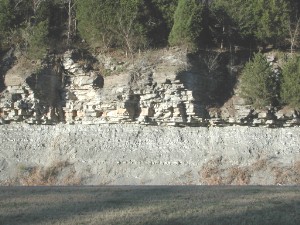Difference between revisions of "Shale" - New World Encyclopedia
(imported latest version of article from Wikipedia) |
|||
| Line 1: | Line 1: | ||
| − | {{ | + | {{Claimed}} |
| − | [[Image:ShaleUSGOV.jpg|thumb|right| | + | [[Image:ShaleUSGOV.jpg|thumb|right|A piece of shale.]] |
| − | '''Shale''' is a fine-grained [[sedimentary rock]] whose original constituents were [[clay]]s or [[mud]]s. It is characterized by thin laminae breaking with an irregular curving fracture, often splintery and usually parallel to the often-indistinguishable bedding plane. This property is called [[Fissility (geology)|fissility]]. | + | |
| + | '''Shale''' is a fine-grained [[sedimentary rock]] whose original constituents were [[clay]]s or [[mud]]s. It is characterized by thin laminae breaking with an irregular curving fracture, often splintery and usually parallel to the often-indistinguishable bedding plane. This property is called [[Fissility (geology)|fissility]]. Non-fissile [[Rock (geology)|rocks]] of similar composition but made of particles smaller than 1/16 mm are described as [[mudstone]]s. Rocks with similar particle sizes but with less clay and therefore grittier are [[siltstone]]s. | ||
Shale is the most common sedimentary rock.[http://wps.prenhall.com/esm_lutgens_foundations_3/0,6540,354318-,00.html] | Shale is the most common sedimentary rock.[http://wps.prenhall.com/esm_lutgens_foundations_3/0,6540,354318-,00.html] | ||
| Line 26: | Line 27: | ||
* [[Siltstone]] | * [[Siltstone]] | ||
* [[Mudstone]] | * [[Mudstone]] | ||
| + | |||
| + | == Notes == | ||
| + | <references/> | ||
==References== | ==References== | ||
* Blatt, Harvey and Robert J. Tracy, 1996, ''Petrology: Igneous, Sedimentary and Metamorphic'', 2nd ed., Freeman, ISBN 0-7167-2438-3 | * Blatt, Harvey and Robert J. Tracy, 1996, ''Petrology: Igneous, Sedimentary and Metamorphic'', 2nd ed., Freeman, ISBN 0-7167-2438-3 | ||
| − | [[Category: | + | [[Category:Physical sciences]] |
| + | [[Category:Earth sciences]] | ||
| + | [[Category:Geology]] | ||
| − | + | {{credit|122868060}} | |
| − | |||
| − | |||
| − | |||
| − | |||
| − | |||
| − | |||
| − | |||
| − | |||
| − | |||
| − | |||
| − | |||
| − | |||
Revision as of 17:59, 16 April 2007
Shale is a fine-grained sedimentary rock whose original constituents were clays or muds. It is characterized by thin laminae breaking with an irregular curving fracture, often splintery and usually parallel to the often-indistinguishable bedding plane. This property is called fissility. Non-fissile rocks of similar composition but made of particles smaller than 1/16 mm are described as mudstones. Rocks with similar particle sizes but with less clay and therefore grittier are siltstones.
Shale is the most common sedimentary rock.[1]
Formation
The process in the rock cycle which forms shale is compaction. The fine particles that compose shale can remain suspended in air long after the larger and denser particles of sand have deposited out. Shales are typically deposited in very slow moving water and are often found in lake and lagoonal deposits, in river deltas, on floodplains and offshore of beach sands. They can also be deposited on the continental shelf, in relatively deep, quiet water.
'Black shales' are dark, as a result of being especially rich in unoxidized carbon. Common in some Paleozoic and Mesozoic strata, black shales were deposited in anoxic, reducing environments, such as in stagnant water columns (see oil shale).
Fossils, animal tracks/burrows and even raindrop impact craters are sometimes preserved on shale bedding surfaces. Shales may also contain concretions.
Shales that are subject to heat and pressure alter into a hard, fissile, and metamorphic material known as slate, which is often used in building construction.
See also
- Bituminous shale
- Oil shale
- Burgess shale
- List of minerals
- Barnett Shale
- Slate
- Siltstone
- Mudstone
Notes
ReferencesISBN links support NWE through referral fees
- Blatt, Harvey and Robert J. Tracy, 1996, Petrology: Igneous, Sedimentary and Metamorphic, 2nd ed., Freeman, ISBN 0-7167-2438-3
Credits
New World Encyclopedia writers and editors rewrote and completed the Wikipedia article in accordance with New World Encyclopedia standards. This article abides by terms of the Creative Commons CC-by-sa 3.0 License (CC-by-sa), which may be used and disseminated with proper attribution. Credit is due under the terms of this license that can reference both the New World Encyclopedia contributors and the selfless volunteer contributors of the Wikimedia Foundation. To cite this article click here for a list of acceptable citing formats.The history of earlier contributions by wikipedians is accessible to researchers here:
The history of this article since it was imported to New World Encyclopedia:
Note: Some restrictions may apply to use of individual images which are separately licensed.


